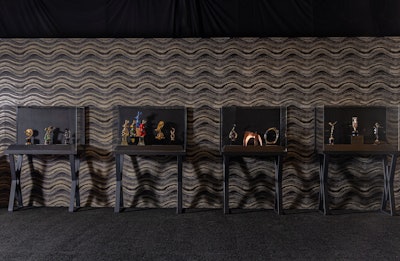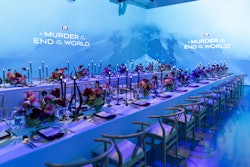
Awards season is upon us. While TikTok is blowing up with Emmys outfit recaps and what John Krasinski did or did not say on the red carpet at the Golden Globes, we’re oohing and aahing over seeing David Moritz’s work everywhere. After all, his work was the star of the show at the Golden Globes and Monday night at the Emmys.
Never heard of him? Moritz is the brains behind Society Awards, the company making the shiny, sleek trophies for all those events and more. This fall, you might have seen his work on the "Moon Person" at the MTV Video Music Awards and "popcorn" at the MTV Movie & TV Awards, or the "golden mic" at the Billboard Music Awards. He recently redesigned the BET Hip Hop Awards prize and is renowned for the orange Nickelodeon Kids' Choice blimp award, the Clio Awards' sleek figure, and the YouTube Awards' big red play button.
Moritz launched Society Awards in 2007. Back then, he had no idea he’d someday be designing the CFDA Awards, GLAAD Awards, or special event awards for fashion icons like David Yurman and TV shows like The Voice.  David MoritzPhoto: Olly Yung
David MoritzPhoto: Olly Yung
“I did entertainment law first, but I wanted to create a luxury brand,” admits Moritz. “I like shiny, sleek things. I like parties. They’re great places to give out awards,” he adds with a chuckle. Moritz's first job for Society Awards was a commission from Billboard magazine to create a small, acrylic memento for Neil Diamond. From then on, being a lawyer was in the rearview. Word of mouth grew, and he began to get a swath of high-end clients who wanted him to design and manufacture high-end custom awards.
“People can’t always tell you or define what they like. We work long and hard to understand their needs and have clients trust us. It is a delicate balance,” says Moritz.
Here, the sought-after award designer tells us six things to consider when creating an award for an event or conference.
1. Come ready with answers.
When an event planner or designer is thinking of reimagining an award or starting an award program, the team at Society Awards will ask questions like: “When, how many, how big, what resources, and what’s essential?” says Moritz. “Then [comes] style. Art or a golden object?”
Event profs might be curious as to what he means by art or golden object. “Making an award is like commissioning an artist,” replied Moritz when we asked him to elaborate. “An artist who very much wants to understand exactly what you’re looking for and what the parameters are [upfront]. Talk to us so you can be more efficient with choosing conceptual paths that are achievable while making beautiful art.”
Concepting a first-time award or reimagining an existing award “can be made difficult or can be solved easily,” he says. “Reimagining an existing award is generally not too different from iterating from a defined concept. Replicating an existing award, especially if it’s a baron’s punch bowl from the 18th century, can be difficult.”
2. Scope out the competition.
Bring photos of what you like, your brand elements, and any competitors’ awards. “We can give you the territory of what else is out there,” says Moritz. Then it’s up to the client to decide “if you’re trying to be unique or within tropes,” he adds.
 Society Awards is behind the design of the "golden mic" trophy for the Billboard Music Awards.Photo: Courtesy of Society Awards
Society Awards is behind the design of the "golden mic" trophy for the Billboard Music Awards.Photo: Courtesy of Society Awards
“In today’s increasingly remote environment, finding ways to show people that they are valued is becoming more important than it’s ever been,” Moritz says. “We’ve all read the studies that relatively small cash gifts don’t carry emotional meaning. Something truly meaningful could be worth more than its cost. In today’s world, the nicest trophy is more affordable than travel, entertainment, and face time, yet it can communicate those emotions: I care, and you are valued.”
For those organizations that have a strict budget, especially for their first award ceremony, Society Awards has a line of high-quality designs that are unique but off the shelf for a better price. “This can be helpful to companies who need a small quantity of high-quality awards in a short period of time.”
4. Don’t be too over the top.
“Tread carefully if innovations are truly necessary. It’s better for an award to be excellent and reliable. It’s not a toy; it is a significant sculpture,” he warns. “A typical award should strive to be subtly or overtly branded commercial art that is both unique and widely appealing.” Easy? “If the award is done well, the design might do a lot of work for you: get you love from the recipient, free advertising, and promote your brand all the way through.”
5. Consider the space in which recipients will display their award.
“As people’s workspaces are increasingly in their homes, we might want to find a way to let branding be more subtle so that our awards can be artwork that can live in a living room,” says Moritz, “maybe even be kept as art generationally. And what is more eco-conscious than that?”
6. Stay open-minded.
“With great clients, you can do anything,” he says. “Innovate, collaborate, create, succeed, celebrate, and have fun!” And isn’t that the point?



















